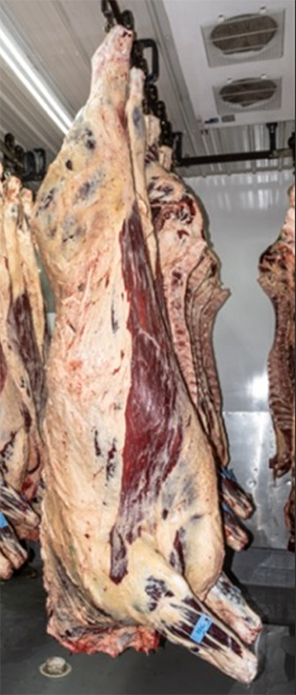Bulletin #1071, What To Expect When Buying A Freezer Beef
By Colt W. Knight, Ph.D., Assistant Extension Professor and State Livestock Specialist, University of Maine Cooperative Extension.
For information about UMaine Extension programs and resources, visit extension.umaine.edu.
Find more of our publications and books at extension.umaine.edu/publications/.

Are you considering buying a quarter, half, or whole beef animal? How much meat can you expect? How much freezer space do you need? Buying locally sourced beef can be an exceptionally rewarding and cost-saving measure, but there are a few key points you need to know before purchasing your beef.
Definitions
Live weight – weight of the animal on the hoof.
Shrink – weight animals loose in transportation.
Dressing percentage = hot carcass weight ÷ live weight.
Hot carcass weight – freshly slaughtered carcass, also referred to as hanging weight.
Cold carcass weight – carcass after cooling.
Cooler shrink – weight lost in the cooling process due to water evaporation.
The national average live weight for finished cattle ready to go to the processor is 1350 lbs, and their dressing percentages range from 58-64% depending on several variables. For example, older cattle have a lower dressing percentage because they have developed larger organs and more external body fat. Also, animals that are too young haven’t developed full muscle structure yet, so they have a lower dressing percentage. Cull cows often have a very low dressing percentage, about 50%. Animals with dairy genetics, like Holsteins or Holstein crosses, dress out 3-5% lower than beef cattle because dairy animals have large bone structure.
Is there a difference between grass-fed and grain-fed beef?
Yes, animals take longer to develop muscle and fat on grass compared to grain-fed cattle. Grain-fed cattle tend to reach slaughter weight at 12-18 months of age, whereas grass-fed cattle are generally 22-30 months old. Grass-fed cattle will dress out 5% lower than grain-fed cattle.
Example
A 1200 lbs grass-fed beef steer would have an expected dressing percentage of 57%, yielding a hot carcass weight of 1200 lbs x 57% = 684 lbs hanging weight. However, we can expect 3-5% cooler shrink due to evaporative losses during cooling and aging, leaving about 658 lbs of cold carcass weight. 684 lbs hanging weight / 1.04 cooler shrink = 658 lbs.
The cold carcass will yield approximately 15-20% bones. 658 lbs / 1.175 = 560 lbs of boneless cuts, even less if the animal has excessive external fat (>1/4”) needing to be trimmed away.
In total, we have 560/1200 = 46.5% of the live weight in meat.
Storing Freezer Beef
You will need approximately 1 cubic foot of freezer space per 35-40 lbs of beef.
560 lbs / 37.5 lbs = 15 cubic feet of freezer space needed for a whole beef, 8 cubic feet for ½ a beef, and 4 cubic feet for ¼ beef.
Beef will keep well for 3-4 days in the refrigerator and 6-12 months in the freezer. Ground beef has a shorter storage time.
Information in this publication is provided purely for educational purposes. No responsibility is assumed for any problems associated with the use of products or services mentioned. No endorsement of products or companies is intended, nor is criticism of unnamed products or companies implied.
© 2020
Call 800.287.0274 (in Maine), or 207.581.3188, for information on publications and program offerings from University of Maine Cooperative Extension, or visit extension.umaine.edu.
In complying with the letter and spirit of applicable laws and pursuing its own goals of diversity, the University of Maine System does not discriminate on the grounds of race, color, religion, sex, sexual orientation, transgender status, gender, gender identity or expression, ethnicity, national origin, citizenship status, familial status, ancestry, age, disability physical or mental, genetic information, or veterans or military status in employment, education, and all other programs and activities. The University provides reasonable accommodations to qualified individuals with disabilities upon request. The following person has been designated to handle inquiries regarding non-discrimination policies: Director of Equal Opportunity and Title IX Services, 5713 Chadbourne Hall, Room 412, University of Maine, Orono, ME 04469-5713, 207.581.1226, TTY 711 (Maine Relay System).

